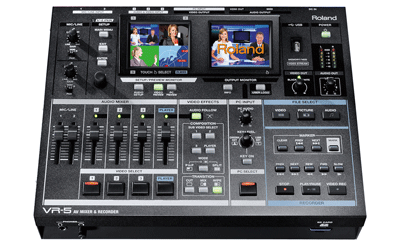Review: Roland VR-5 A/V Mixer
Roland's VR-5 A/V Mixer features multiple video inputs, an internal media player, computer input and conversion, a built-in audio mixer, two integrated LCD monitors to see video inputs, output and various device settings, and the ability to internally record your program output while also sending your program to a laptop for streaming--all for an MSRP of $4,995.
In this age of "one device does everything," Roland-a name more associated with audio gear than video-has been producing some quite capable video mixers, recorders, and players. The company's latest mixer, the VR-5, features multiple video inputs, an internal media player, computer input and conversion, a built-in audio mixer, two integrated LCD monitors to see video inputs, output and various device settings, and the ability to internally record your program output while also sending your program to a laptop for streaming-all for an MSRP of $4,995.
Sound too good to be true? Well, after working with the VR-5 I can tell you that they pull off nearly all of it with aplomb.
Hardware
Powering on the VR-5 treats the user to a light show (all the LEDs flash in turn in a wave) and a system bootup that takes about 30 seconds. If you have saved parameters, they should load automatically. If you rent the mixer, you can save your personal parameters to the SD card and load them in after you boot the unit up.
The VR-5 is two inches shy of a standard rack width (you could mount it on a rack on a shelf and have room on the side) and all the jacks are on the back, except for the USB out, which is on top; the headphone jack, which is on the front; and the SD card slot, which is also on the front. On the back there's a phantom power switch for the microphone inputs.
Aside from that, plus the headphone volume on the front next to the headphone jack, all the controls are on the top surface. This simplifies operation in that you don't have to go hunting down a control for a feature you need to access quickly during a live event.

The Roland VR-5 A/V Mixer
Moreover, the two LCD screens are actually touchscreens. To the left of the left preview screen, there are buttons that call up the Setup Menus, Exit, and Enter, as well as a dial to select from different items. The dial knob also presses down, but this feature is not used to enter. In fact, we've all become so accustomed to small touchscreens on our cell phones, that we may find ourselves using the touchscreen almost exclusively; once I started using the touchscreen to navigate the VR-5 menus, I never touched the other setup buttons. The menu layout is pretty intuitive and I found that I could adjust different parameters fast.

Touchscreen menu control on the VR-5
There's also an Audio Setup menu button below the Preview monitor that takes you directly to the audio parameters-a handy short cut. But, given as it takes you only one touch further than the Main Menu button, and given how fast the menu system is, I think Roland could change the Audio Setup into the Main Menu button and get rid of the three other buttons and the knob in the Setup section of the mixer. There's really no need for the redundancy, or the hardware.
The menu system (download the VR-5 manual at RolandSystemsGroup.com for details) gives you access to a plethora of parameters for video, audio, computer input, recording, and more. I was quite pleased with the VR-5's customizability as I was tweaking the width, height, and position of the computer input's image by tapping the VR-5's touch screen.
The right Output Monitor screen, while seemingly not needing "touch" capability, has a usefulness all its own. When you put up a Picture in Picture (PiP), you can touch the Output screen and position the PiP wherever you'd like on the screen. I was quite surprised by this very tactile functionality. The VR-5 will remember this position through a reboot but, as I said, you can also save your parameters to the SD card and take them with you.
You can drag the image across the screen while it mixes foreground and background video, but the movement is not smooth and not something I'd use during a live show. You can change the position of the PIP during a live show, but keep it off the program output, by changing the position parameters in the menu system. However, I'd suggest that you find the position visually and write down the numbers before your program begins.

PiP and Wipe controls on the VR-5
Related Articles
This capture software was developed to meet the request from Windows users who want to record/capture the audio and video during live events using any of the products from the Roland VR or VC line-up
New switcher designed for live events and installations, augments V-1600HD and V-800HD lineup with 12 inputs on 4 channels plus 1 (background), and 2 output buses with independent scalers on the inputs and outputs allowing you to connect HDMI/DVI, RGB, component, and composite sources